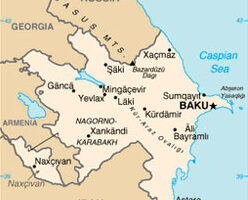Calls For Restraint After Deadly Armenia-Azerbaijan Border Clashes

(Article text ©2020 RFE/RL, Inc., Radio Free Europe/Radio Liberty – rferl.org – July 14, 2020 – article text also appeared at rferl.org/a/calls-for-restraint-after-deadly-armenia-azerbaijan-border-clashes/30725069.html)
Armenia and Azerbaijan remained on edge on July 14 following two days of deadly border clashes that prompted international calls for immediate de-escalation.
The two neighbors in the South Caucasus region have blamed each other for starting the latest flare up along their volatile border.
Azerbaijan’s Defense Ministry said on July 14 that 11 of its armed forces personnel, including Major General Polad Hasimov and Colonel Ilqar Mirzayev, had been killed and several more wounded since clashes erupted on July 12, while Armenia’s Defense Ministry said three of its soldiers and two police officers had been wounded.
Both sides reportedly used artillery, mortars, and tanks in the northern area of their border near the village of Tavush.
The Armenian Foreign Ministry said the artillery fire from Azerbaijan “receded” later on July 13, claiming Yerevan was “fully controlling” the situation.
“Armenia’s political and military leadership will bear the entire responsibility for the provocation,” Azerbaijan President Ilham Aliyev said on July 13.
Armenian Prime Minister Nikol Pashinian accused Azerbaijan of “provocations” that would “not go unanswered.”
Azerbaijan’s Defense Ministry claimed 100 Armenian troops were “destroyed and wounded” alongside military equipment and accused Yerevan of “hiding its losses.”
The Armenian Defense Ministry denied the losses, calling the reports “disinformation.”
The two neighbors have been locked in a conflict over Azerbaijan’s breakaway region of Nagorno-Karabakh for years.
But the clashes over the past two days were far from Nagorno-Karabakh and directly between the two nations, which occur rarely.
The European Union, United States, and Russia urged restraint in a series of statements on July 13.
Calls For Calm
Russian Foreign Minister Sergei Lavrov held phone conversations with his Armenian and Azerbaijani counterparts, urging de-escalation between the two countries with which it has close relations.
Russia’s Foreign Ministry expressed “serious concerns” over the clashes, which it said “endanger the region’s stability,” urging the countries to “show restraint.”
The U.S. State Department urged both sides to adhere to a cease-fire and resume negotiations in a bid to achieve a peaceful settlement of the Nagorno-Karabakh conflict.
In a statement, the EU urged both sides to “stop the armed confrontation, refrain from action and rhetoric that provoke tension, and undertake immediate measures to prevent further escalation.”
The clashes came days after Azerbaijani President Aliyev raised the possibility of a new war with Armenia and denounced stalled peace talks.
On July 7, Aliyev threatened to withdraw from negotiations “if they yield no results.” He did not provide further details.
Mainly ethnic Armenian-populated Nagorno-Karabakh declared independence from Azerbaijan amid a 1988-94 war that claimed an estimated 30,000 lives and displaced hundreds of thousands of people.
Since 1994, it has been under the control of ethnic Armenian forces that Azerbaijan says include troops supplied by Armenia. The region’s claim to independence has not been recognized by any country.
Negotiations involving the Minsk Group of the Organization for Security and Cooperation in Europe (OSCE), co-chaired by Russia, the United States, and France, helped forge a cease-fire in the region, which is not always honored, but have failed to produce a lasting settlement of the conflict.
With reporting by RFE/RL’s Azerbaijani Service, AFP, AP, Reuters, TASS, and dpa
